Vital Thrills got a chance to attend an early preview of Turning Red and learned all about the upcoming Disney/Pixar film from director Domee Shi, producer Lindsey Collins, and some of the production team.
Turning Red introduces Mei Lee (voice of Rosalie Chiang), a confident, dorky 13-year-old torn between staying her mother’s dutiful daughter and the chaos of adolescence. Her protective, if not slightly overbearing, mother, Ming (voice of Sandra Oh), is never far from her daughter – an unfortunate reality for the teenager.

And as if changes to her interests, relationships, and body weren’t enough, whenever she gets too excited (which is practically ALWAYS), she “poofs” into a giant red panda!
Director Domee Shi is known for the short film Bao, which received some major acclaim. Shi explained, “Back in 2017. as I was promoting my short film Bao, a lot of people kept asking me why is Bao a boy? Why is this little dumpling a boy? And I was like, Oh, because I only had eight minutes to tell this story, for a mother/daughter story, I’d need an entire feature film to unpack that. But luckily, I was soon given the opportunity to do a lot of unpacking when Pixar asked me to pitch some ideas for a feature film.
“And when you go into development at Pixar, you are asked to pitch three ideas. So you’re basically not putting all of your eggs into one basket. All of my ideas were coming-of-age teen girl stories because that was something I was super passionate about telling, and at the time, it wasn’t something that I saw a lot in media and in animated films.”
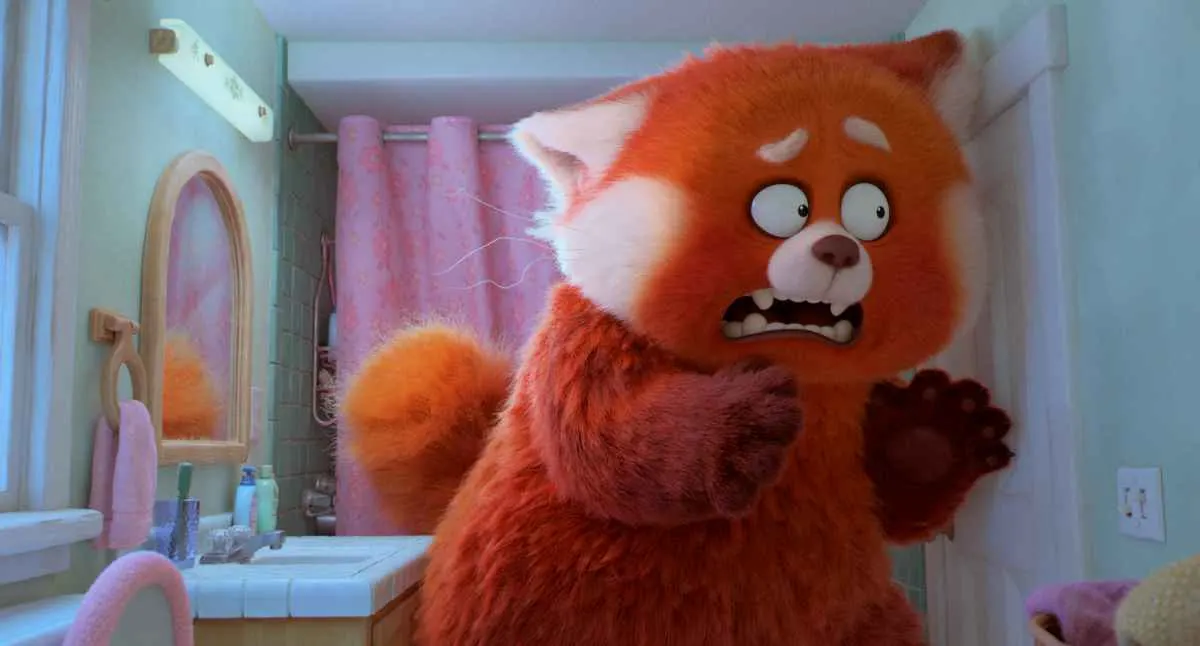
She said the film was inspired by her relationship with her own mother. She explained that she is an only child and that her family moved from Chongqing, China, to Toronto, Canada, when she was two years old.
She said, “I’m super close to my parents, especially my mom, since my dad had to go away for work often. It was just the two of us. We did everything together. We commuted together to work and to school in downtown Toronto, we went on mother/daughter bus trips and vacations together.”
She said that as she grew up, though, she got into other things like anime, comics, and friends, and her mom didn’t understand. “She didn’t understand why I was obsessed with these fictional characters with huge eyes and colorful, spiky hair,” Shi said. She was being pulled in different directions by her family and her friends.
“Turning Red is just inspired by this universal struggle of growing up and trying to figure out how to honor your parents but also stay true to yourself. For Mei Lee in the movie, the red panda is that magical spark that sets off this internal conflict within herself because up until that point. Mei thinks she has it all figured out, like we all did before we woke up one day and realized all of a sudden, we’re covered in body hair, we smell funky, and our emotions are all over the plays and we’re hungry like all the time.”
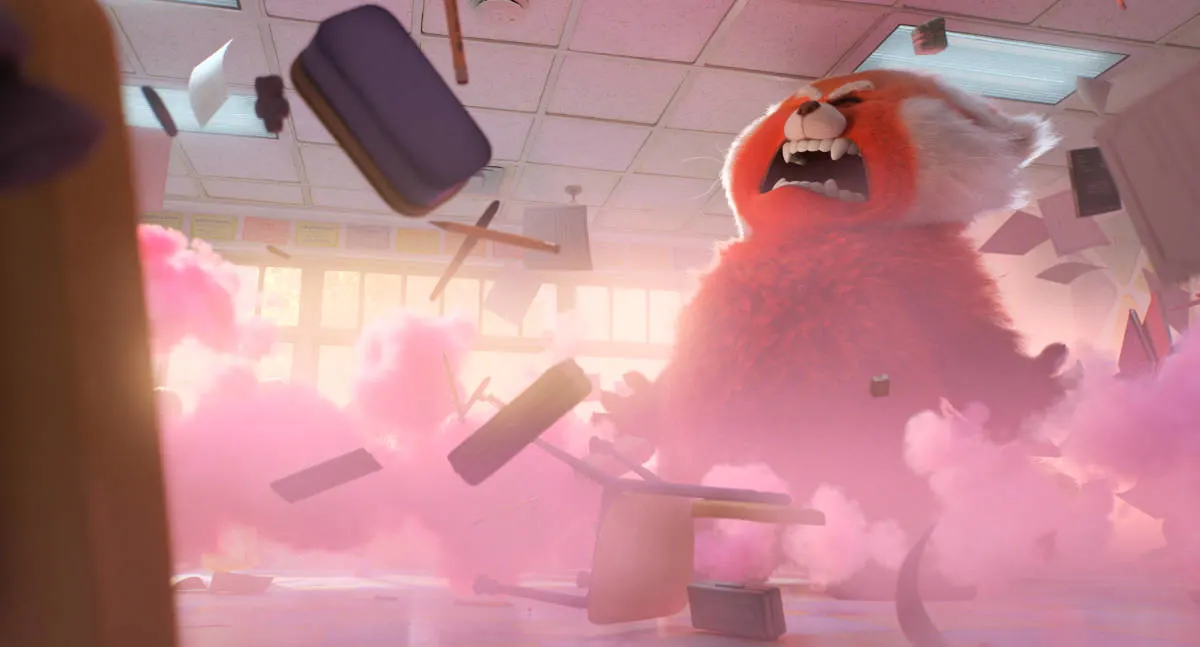
Shi explained that the red panda in Turning Red is “an adorable metaphor for the scary, un-adorable, awkward, and cringy changes we go through during this age. And more specifically, we want to explore the nuances of Asian parent/child relationships and dealing with change and all of the intergenerational conflict and how it shapes who we become.”
Producer Lindsey Collins, who produced features like WALL-E and Finding Dory, said she loved the ideas that Shi pitched. “This is the first time that there has been an all-female leadership team on a feature film. I’ve been surrounded by incredibly talented women throughout my career at Pixar, so it’s not surprising that we landed a team of women at the top, but it was also incredibly exciting.
“Once we assembled the team, we all had to learn how to embrace the awkward — I think scripted it says awesome 13-year-old versions of ourselves… the truth is that I cannot say, kind of for certain if being led by an all-women leadership team had a quantifiable effect on the movie or how we made it because, after all, we’ve all kind of worked on several movies here.
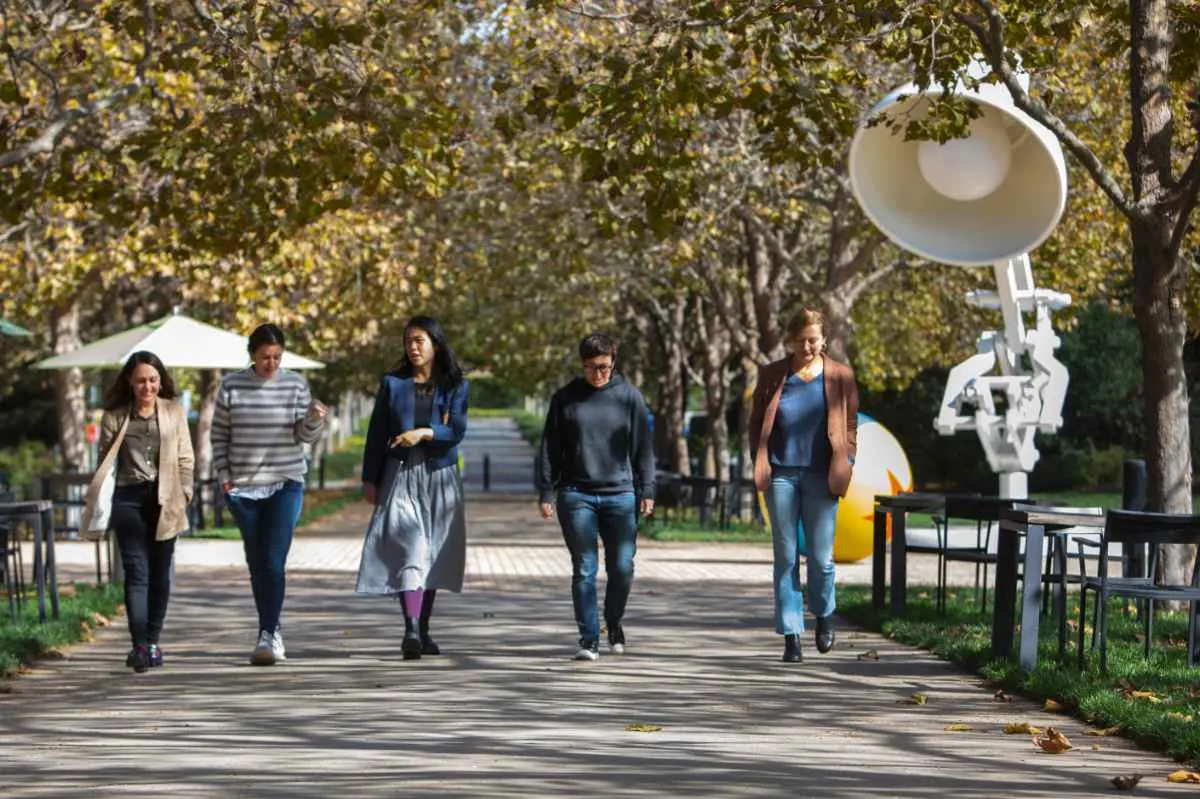
“So it’s not really tangible or explainable, but I do know that working on this movie every day and looking around our production pod with all the Zoom meetings that we had over the past four years really kind of inspired something unique in all of us. And that kind of indescribable spirit of pride and excitement and fun, it just shines through in the movie and you’ll eventually hopefully get to see the whole thing, and feel that same feeling on the screen.”
In the film, we see a young girl who is dealing with turning into a red panda when she’s excited or upset, and we learn that this is something her family knew was going to happen beforehand. The visuals have been described by the team as “chunky cute,” and the style of animation follows that. We watched a video during the Turning Red early press day that gave us a look at how everything followed that pattern, from the walls of the temple that our main characters run to the school accessories that Mei Lee and her friends have.
There are even jokes and references to a very BTS sort of band that the girls have a huge interest in. It absolutely captures that intense emotion and hair-trigger explosions that go along with being a 13-year-old girl.
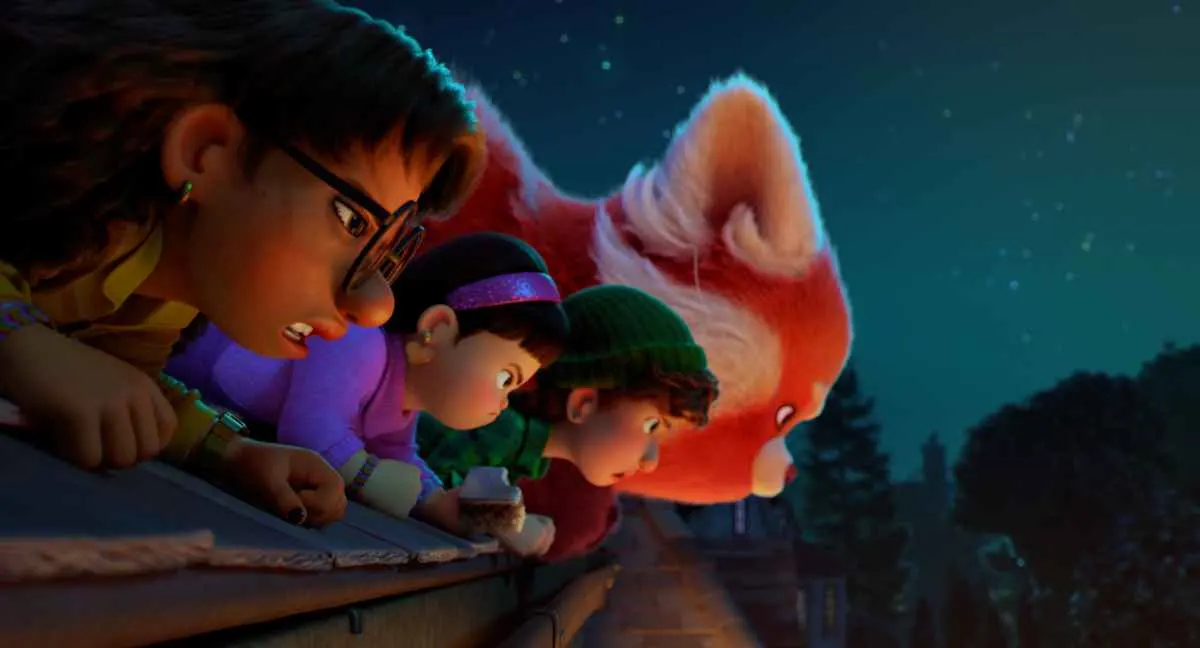
The crew, according to Collins, even brought in their middle school yearbooks and shared stories of their awkward school moments, moments with parents, and their failures and successes. They even showed the moment on film where they told Rosalie Chiang, the 12-year-old girl whom they’d hired to do the scratch track for the vocals, that she’d gotten the part.
We were also introduced to Mei’s group of friends, including Ava, with her “cool tomboy vibe – we felt like she was the coolest best friend, and she also had this amazing singing voice.” Then there is Abby, “the friend you want next to you in any situation — she’s not afraid to throw a punch in defense of her bestie; she’s like the muscle of the group.”
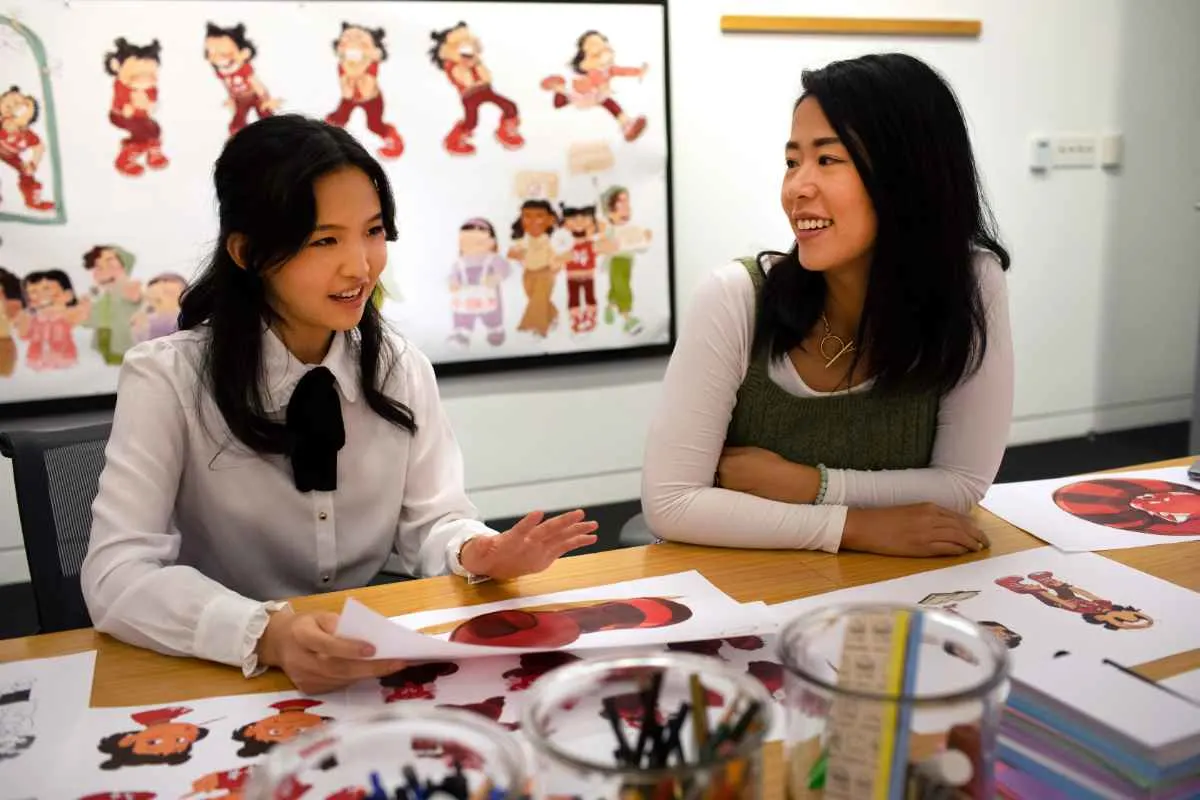
Production supervisor Rona Liu said of Mei Lee, “She’s a Chinese girl growing up in Toronto, and her life is a blend of two very different cultures. For Domee, this film came from a personal place with her relationship with her mom, so for the look, she encouraged me to tap into my own feelings of growing up with my mom.
“And for some of the early sketches, I looked at photographs of my mom and I and those actually inspired the final photos in the opening of the film. We were constantly looking back at ourselves when we were 13 and wanted to capture all of the ups and downs of tween life.
“We also wanted to put into the film all of the things that we loved at that age. So we were asking ourselves what influenced our aesthetics when we were 13, and the answer was a mix of east meets west. Our teenage years were filled with best friends, boy bands, punky music videos, and glitter accessories. And we also watched a lot of anime movies and TV shows. And we wanted to mix in that chunky, cute design sensibility, expressive character designs, and poppy color palettes.”
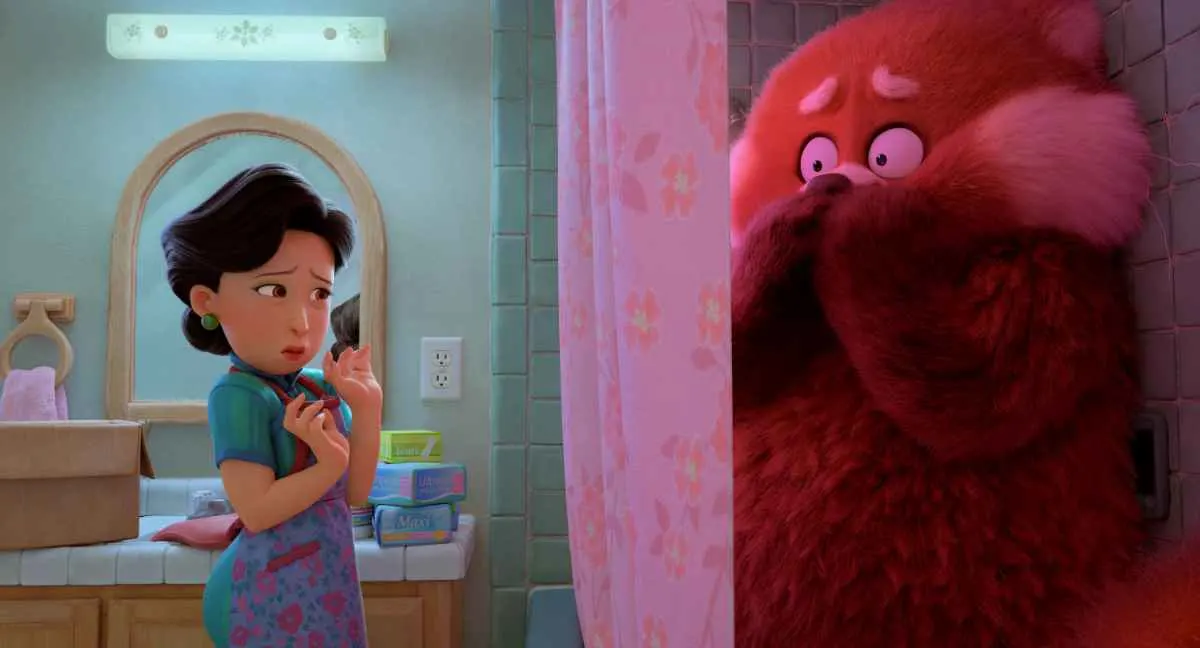
Shi added, “So we began to imagine what Mei’s world would look like and started to explore the world through her paintings. What does a CG film inspired by anime and teenagers look like? Since everything is seen through a 13-year-old’s lens, we imagined that Mei’s world would be very vibrant and very colorful. Our Toronto would be filled with bright and beautiful pastel colors, and our nighttime would feel dreamy and full of city lights.”
On the panda side of things, Liu said, “Mei Panda symbolizes all of Mei’s intense feelings, so it’s really important that she feels cute, but also gives the vibe that she is messy and doesn’t have it all together. We made her figure round and chunky. Her fur is ultra fluffy but also clumpy in areas to show that she’s not perfectly groomed. And we designed her whiskers to be uneven and crinkled.
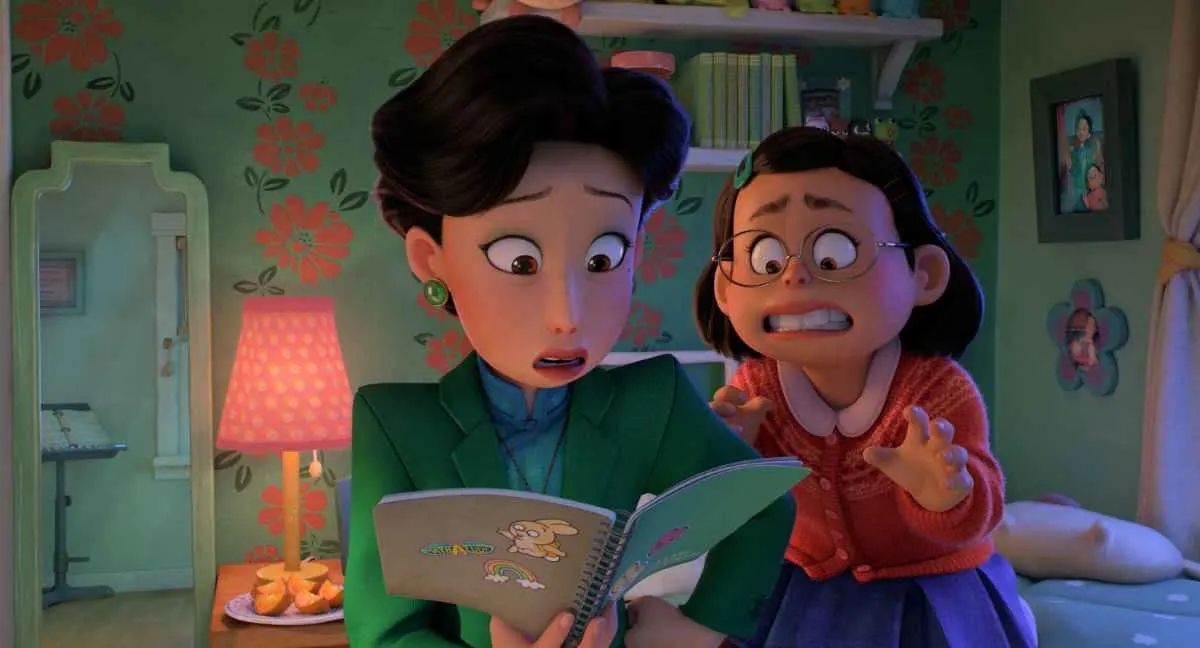
“And to give the vibe that she is a magical red panda, we gave her a little swirl on each arm. And Mei Panda needed to feel visually trapped in this body that she was not comfortable in, and we needed to make her look like she didn’t actually belong in the house. So we did these early tests for scale to make sure that she’s actually too big for her home.
“We made her big enough that her ears are grazing the ceiling, and she can’t fit through the doorway. Human Mei is a confident dork. For her, we actually looked to ourselves. The chubby cheeks we had as teens, the sparse eyebrows, and the way that we have moles sprinkled across our faces. We gave Mei a pink Peter Pan collar shirt with a thick knitted cardigan so that she looked like Ming’s good girl. And a denim skirt to give her that early 2000s flair. And we explored what Mei would look like in front of her mom.

“Her posture would look very demure, and her hair and outfit would be very put together. And she is Ming’s mini-me. But deep down, she’s this hormonal 13-year-old who, at times, is unable to control all of her emotions. And that is her true self that is trying to break free. She gets excited when she sees something cute. She cries with laughter, and she freaks out from time to time.
“And we looked towards anime for inspiration for her multitude of expressions. Stars in her eyes when she’s amazed. Giant droplets of tears when she’s sad and pupils that can shrink down to a dot when she panics.”
From what we saw in the footage, Turning Red is the cutest exploration of the most awkward time in a girl’s life. The film will hit Disney+ on March 11, 2022.

Jenna Busch has written and spoken about movies, TV, video games, and comics all over the Internet for over 15 years, co-hosted a series with Stan Lee, appeared on multiple episodes of “Tabletop,” written comic books, and is a contributing author for the 13 books in the “PsychGeeks” series including “Star Wars Psychology.” She founded the site Legion of Leia and hosted the “Legion” podcast.